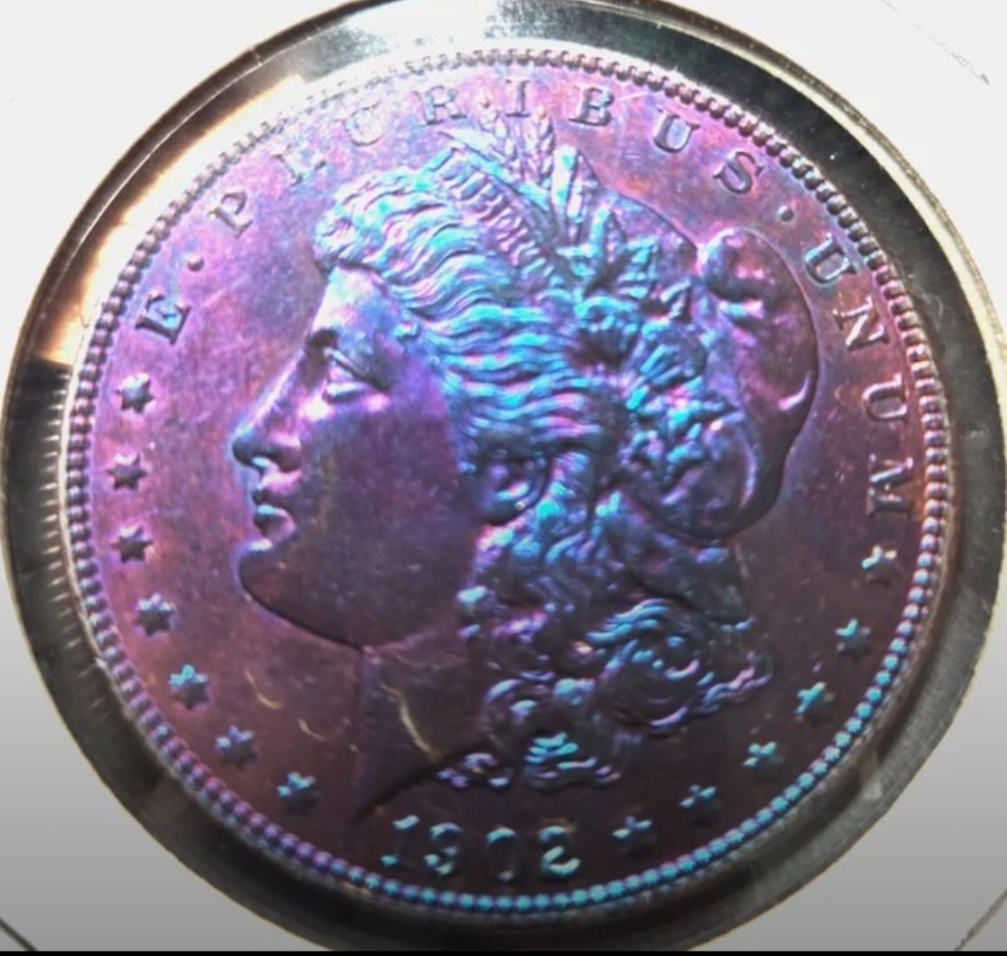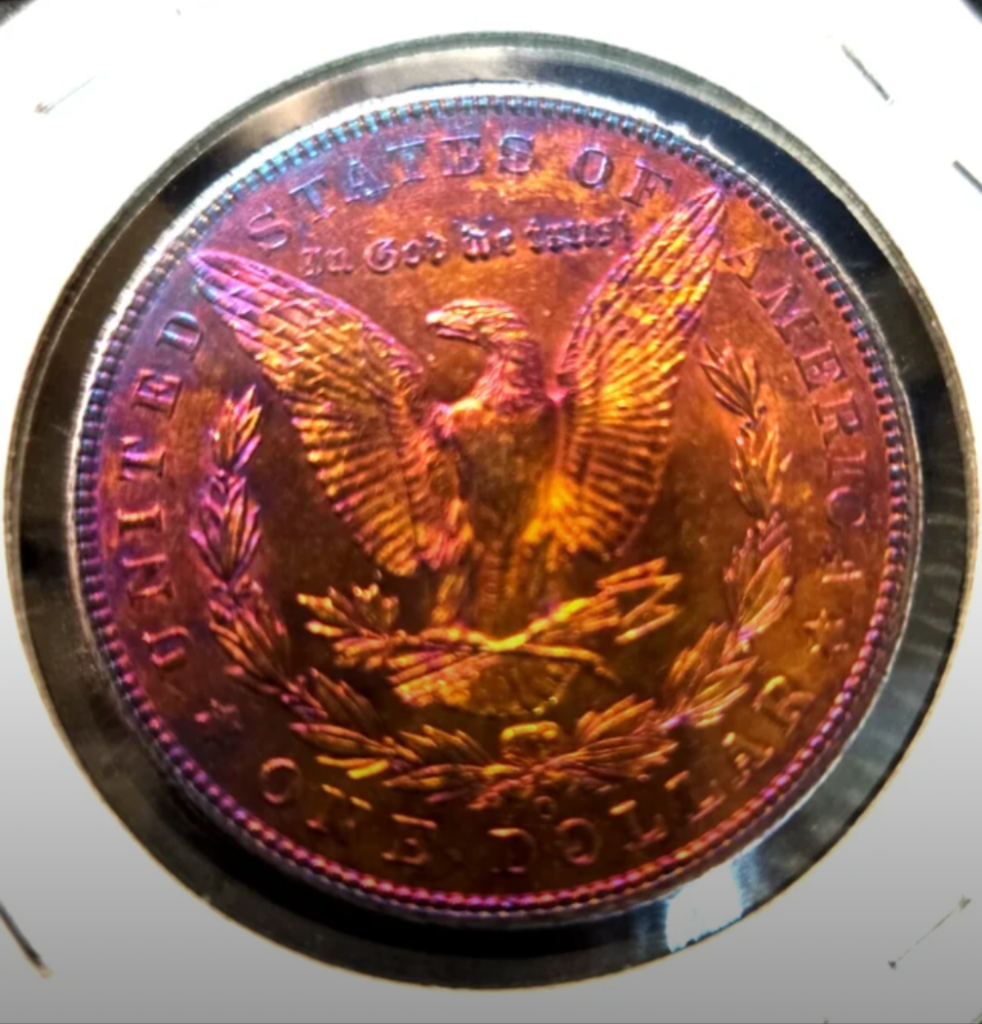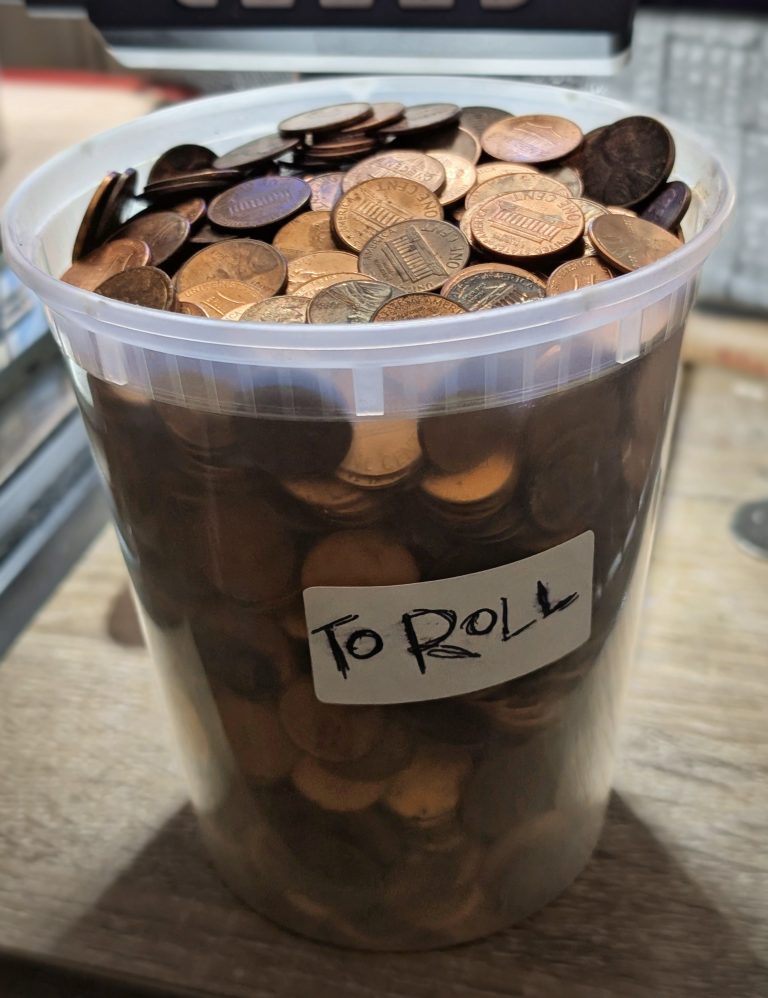Fake Toning: Pretty Coins, Ugly Truth

This 1902 Morgan dollar sports deep purple and electric blue hues that might look natural to the untrained eye, but the even, glassy coating and unnatural color pattern suggest artificial toning.
Some coins earn their color the hard way. They sit in envelopes, albums, or mint sets for decades, slowly picking up hues from their environment. Others take a shortcut. They get dunked in sulfur, baked in ovens, or blasted with heat just to grab attention and a higher price tag. That’s fake toning.
At first glance, artificially toned coins can look stunning. You’ll see blazing rainbows, deep purples, and electric blues. But behind the flashy colors is often a coin that’s been altered, and not in a good way. Fake toning isn’t just a cosmetic choice, it can affect the coin’s value, marketability, and long-term stability.
This post breaks down what artificial toning is, why people do it, how to spot it, and what to do when you find one. Whether you’re just starting out or already deep into toned Morgans, knowing the difference between natural and artificial color is one of the most valuable skills you can develop.
What Is Artificial Toning?
Artificial toning is any intentional process used to change the color of a coin after it leaves the mint. These methods aim to mimic the natural rainbow patina that develops over decades, but they do it in minutes or hours. The results can be dramatic (sometimes beautiful, sometimes obviously fake) but they’re always the product of chemistry done on purpose.
There are dozens of ways to artificially tone a coin. Some people use sulfur-rich materials like eggs or liver of sulfur to speed up oxidation. Others bake coins in the oven or heat them with a torch. Some use chemicals that react with the metal surface to bring out vibrant colors. The goal is always the same: to simulate that magical iridescent look that collectors pay premiums for.
But make no mistake, this isn’t natural aging. These shortcuts can damage the coin’s surface and fool collectors into thinking a coin is more valuable or original than it really is. Once you know what to look for, spotting artificial toning becomes a lot easier and more fun.
Why People Do It
There are two main reasons someone would artificially tone a coin: to make money, or for fun.
On the shady side, sellers sometimes use fake toning to make common coins seem rare or more eye-catching. A naturally toned coin with strong luster and vibrant colors can fetch a serious premium, especially on silver issues like Morgans, toned proofs, bullion coins and American Silver Eagles. By artificially toning a coin, someone might hope to pass it off as naturally toned and trick a buyer into overpaying.
On the innocent side, some collectors just enjoy the look. There’s a niche group of hobbyists who intentionally tone coins for the art of it, sometimes even on junk silver or replicas. These folks aren’t trying to fool anyone, and some will even mark their pieces clearly or keep them outside their regular collection. The intent makes all the difference.
Whether done to deceive or just to experiment, artificial toning always changes how the surface reflects light. That’s what gives it away.
How to Tell If a Coin Has Fake Toning

The reverse of the same 1902 Morgan dollar shows a fiery mix of red, orange, and purple with a suspiciously uniform rim halo and hard color breaks. All classic signs of heat-induced artificial toning.
Spotting fake toning takes some practice, but there are a few consistent signs to watch for.
1. Unnatural color patterns. Real toning tends to follow the metal’s surface contours. On silver, it often starts at the edges and fades toward the center in soft transitions. If you see perfect rings of bright blue or magenta, or weirdly blotchy colors that don’t flow with the design, be skeptical.
2. Uniformity or inconsistency. Fake toning is often too even or too patchy. Natural toning is influenced by how a coin was stored. It’s rarely perfectly balanced. A coin with bright rainbow colors on both sides but no evidence of long-term exposure probably wasn’t stored that way for decades. Some artificial toning fades, darkens, or turns patchy over time.
3. Lack of luster. One of the biggest giveaways is when the colors are bold but the cartwheel effect is gone. Real toning often enhances luster in certain lighting. Fake toning, especially from heat or chemicals, tends to dull the surface instead.
4. Chemical smell or residue. If you’ve got the coin in hand, a lingering chemical scent or rainbow smudges that wipe off are a dead giveaway. Some artificial toning methods don’t bind well to the surface and leave behind a sticky or powdery layer.
5. Coin type and context. Some coins are more likely to develop natural toning than others, based on how and where they were stored. But keep in mind that true toning is a slow chemical reaction that takes years, even decades, to build up those colorful surface films. If you see a 1999 Lincoln cent with deep blues, purples, and golds, it’s worth asking how that could’ve happened. In normal circulation or album storage, there just hasn’t been enough time for dramatic color to form naturally. That doesn’t mean every modern toned coin is fake, but the more recent the date, the more skeptical you should be. Especially if the seller has a whole lineup of similar coins.
6. What to Do If You Find One
If you come across a coin with wild toning that seems too good to be true, treat it with caution. Just because it looks dramatic doesn’t mean it’s worth more. In fact, most artificially toned coins carry no premium and can even lose value if the treatment is obvious or unappealing.
That said, you’re not breaking any rules by keeping it. If you genuinely like the look, go ahead and collect it. Just be honest with yourself and others. Label it clearly in your flips or storage as likely artificial. Avoid paying top dollar unless you’re certain it’s a naturally toned coin with verified provenance.
Reselling these coins can be tricky. Many buyers are skeptical, and some marketplaces crack down on misleading listings. If you do decide to sell, disclose everything. That protects your reputation and helps prevent more confusion in the hobby. There are definitely situations where fake toning can increase the value, from an artistic standpoint. This is not the norm though, and most add no value. Some collectors collect artificially toned coins (Morgans, from what I’ve seen), so there is a niche market for them.
To see it from the other side, check out our post on Tarnish vs. Toning.
Should You Try It Yourself?
Some collectors experiment with artificial toning out of curiosity or for artistic reasons. There are forums and videos that walk through different heating or chemical methods, and it can be tempting to try it just to see what happens.
But here’s the line you should never cross – never try it on a valuable coin. Artificial toning may seem harmless, but it can permanently reduce the coin’s resale value and damage the metal if done incorrectly. Once a coin is altered, it can never go back.
There’s also an ethical side to this. Even if you don’t plan to sell it, the coin might eventually end up in someone else’s hands. Misunderstandings or dishonest resales can confuse the market and hurt trust within the hobby.
If you do experiment, keep it contained to damaged coins or those with no numismatic premium. Always mark them clearly so they stay out of circulation and off the marketplace.
Closing Thoughts
Artificial toning can look impressive at first glance, but it often lacks the depth and beauty of natural patina. Learning to spot the difference takes time and practice, but it pays off in the long run.
Trust your eye, but also verify. Study how genuine toning behaves across different coin types and metals. Natural progression tends to follow a predictable flow of color and coverage, while fakes often look forced or too dramatic.
Finally, share what you learn. The more collectors who can recognize these alterations, the healthier and more honest the hobby becomes.
Geoff runs Genuine Cents, a straight talking coin education project built from hands-on experience and hundreds of hours examining coins. He is an ANA member and writes practical guides for new and returning collectors who want clarity instead of hype. If you want to reach him, message him on Instagram at @GenuineCents.

